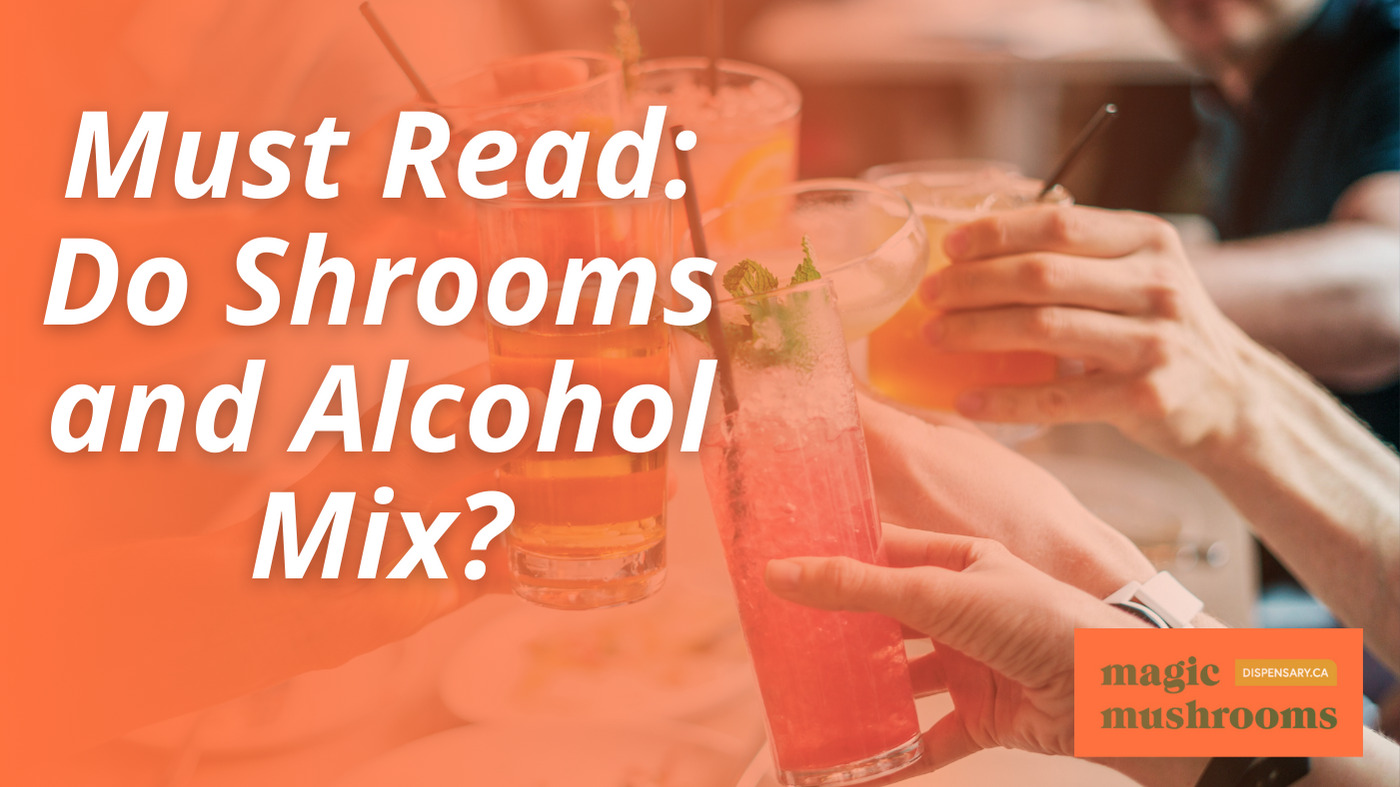In a time when psychedelic substance usage is increasing, the question arises regarding the possible interactions and outcomes of mixing these substances. Specifically, the interplay between psilocybin mushrooms (commonly referred to as ‘shrooms’) and alcohol presents a concern regarding safety and the effects on one’s health. Given that scientific understanding of these interactions is still limited, it’s essential to delve deeper into this subject. This discussion is intended to illuminate the topic, compiling existing studies and expert viewpoints to foster a well-informed conversation on the consequences of combining shrooms and alcohol.
Key Takeaways
- Combining shrooms and alcohol intensifies impairment and increases potential risks.
- Alcohol can exacerbate the disruption caused by psilocybin, leading to negative emotions and mood swings.
- Experts strongly discourage the mixing of shrooms and alcohol due to health and safety concerns.
- Legal repercussions for possession and distribution of psilocybin mushrooms can include fines and imprisonment.
Understanding Psychedelic Substances
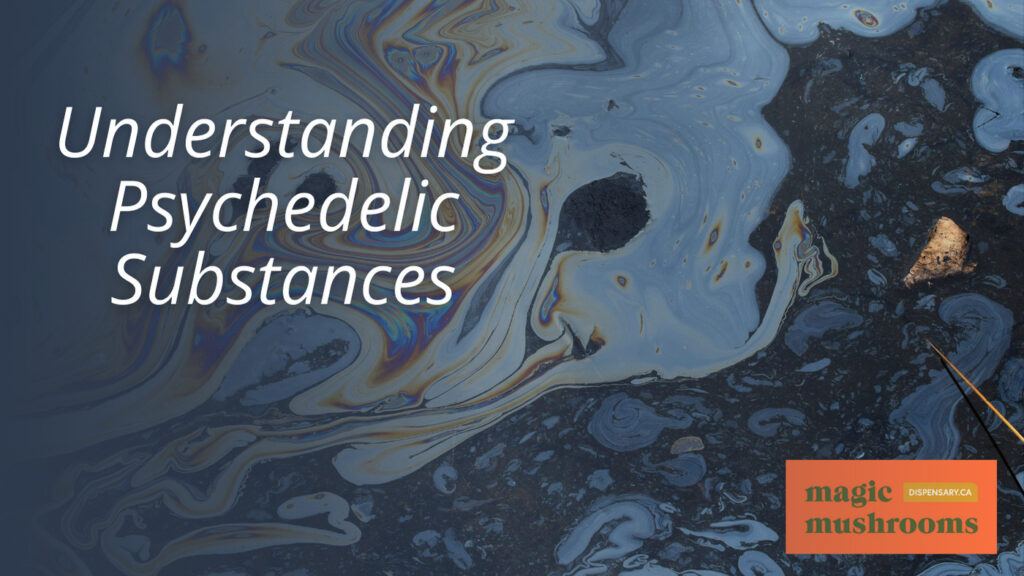
To comprehend the potential effects and risks of mixing shrooms and alcohol, it is essential to first understand the nature of psychedelic substances like psilocybin mushrooms. Psychedelic substances, also known as hallucinogens, are chemical agents that substantially alter perception, cognition, and mood.
Mushrooms containing psilocybin, commonly referred to as shrooms, hold a prominent place in this category. The psilocybin in these mushrooms interacts with the brain’s serotonin receptors, causing changes in thought processes and sensory perception, often experienced as hallucinations. These alterations can vary significantly between individuals and instances of use, adding a level of unpredictability to their effects.
Other hallucinogens like LSD and peyote work in similar ways, inducing changes in mood and perception. Some substances, classified as dissociative drugs such as PCP and ketamine, cause feelings of detachment from reality, adding another layer of potential risk and complexity.
In addition to their unpredictable effects, hallucinogens can be consumed in various forms, including as tea, in liquid form, or as pills. This versatility in consumption methods may contribute to their misuse, leading to potential dangers.
The prolonged use of hallucinogens can lead to persistent psychosis, a condition characterized by continued mental problems, including disorganized thinking, paranoia, and mood changes. This all underlines the importance of understanding the nature and risks of psychedelic substances before deciding to mix them with other substances like alcohol. Understanding the complexities and risks associated with psychedelic substances is the first step towards making informed and responsible decisions regarding their use.
What Are Shrooms?
Having explored the general nature of psychedelic substances, we can now focus specifically on psilocybin mushrooms, commonly known as shrooms. These are a type of mushroom that contains the hallucinogenic compound psilocybin, a naturally occurring psychedelic compound responsible for the altered states of consciousness experienced by users.
Shrooms are found globally, with a particular abundance in tropical and subtropical regions such as South America, Mexico, and certain parts of the United States. They are typically consumed in their raw form, though they can also be brewed into a tea or incorporated into food items. This versatility in consumption methods lends itself to the appeal of shrooms among those seeking liberation from conventional approaches to consciousness.
While the effects of shrooms (which we will discuss in the next section) can be intense, it’s important to note that psilocybin is generally considered safe and non-addictive. However, this does not mean that their consumption is without risks, particularly when combined with other substances such as alcohol.
Understanding what shrooms are, their origins and the way they interact with the human brain is crucial for anyone considering their use. It is also the first step towards making informed decisions about consuming these substances, ensuring you prioritize your safety and well-being over all else. So, before you delve into any exploration of consciousness via shrooms, make sure you have a solid grounding in what these psychedelic mushrooms are and the potential risks and interactions associated with their use.
The Effects of Shrooms
Delving into the effects of shrooms, it’s critical to understand that these are primarily driven by the hallucinogenic compound psilocybin, which competes with serotonin in the brain, leading to a range of physical and psychological alterations. The impact of this competition with serotonin may result in a perceptual distortion, creating an altered sense of reality. This can manifest in visual, auditory, and sensory hallucinations, as well as changes in thought processing and time perception.
A euphoria often accompanies the hallucinogenic experience, creating feelings of joy, wonder, and increased connectivity with the world. However, physical effects such as pupil dilation, rapid heartbeat, and facial redness can also occur. The intensity and nature of these effects can be influenced by numerous factors including body weight, the potency of the mushrooms, previous usage, the setting in which they are consumed, and the individual’s mental state.
While these experiences can be profound and even spiritual for some, it’s essential to remember that they carry risks. Overconsumption can lead to a distressing experience, often referred to as a ‘bad trip’, which can cause panic, fear, and even psychosis in extreme cases. There’s also a potential for addiction to hallucinogens like shrooms, despite common misconceptions.
Alcohol: A Brief Overview
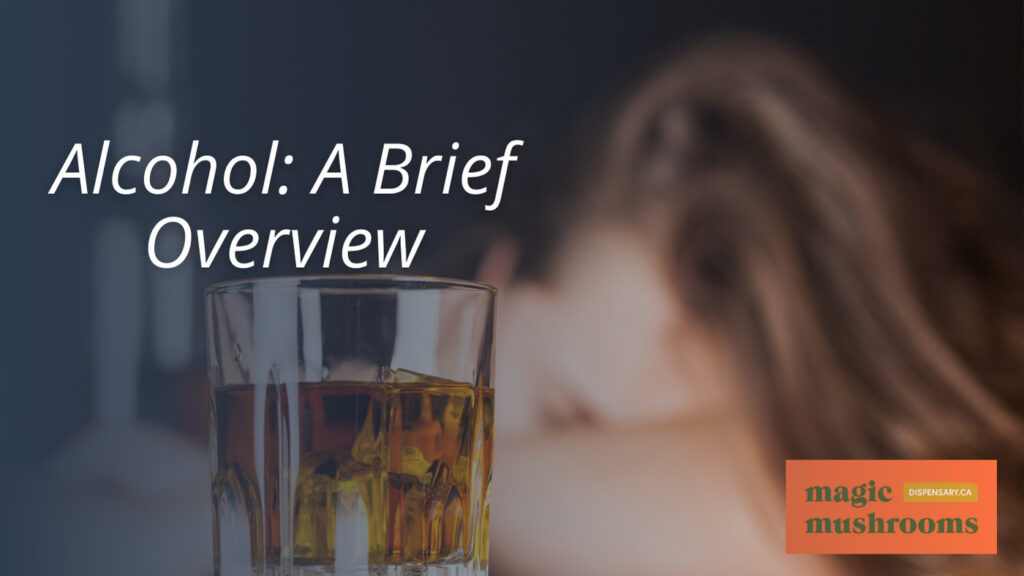
In the realm of psychoactive substances, alcohol, a central nervous system depressant, holds a significant position due to its widespread use and potential for misuse. The active ingredient in alcohol is ethanol, a compound that induces relaxation, altered perception, and impaired judgement. This psychoactive effect, while often sought for its reprieve from stress, can also lead to dangerous situations, particularly when the user’s ability to make sound decisions is compromised.
The consumption of alcohol is not merely a social or recreational activity; it is a potentially harmful habit with severe consequences for the unprepared or uninformed. Short-term effects like slurred speech and slowed reflexes can escalate to more serious complications like blackouts and alcohol poisoning. More insidiously, chronic excessive drinking can lead to a plethora of health issues, including liver damage, heart problems, and cognitive impairment.
Furthermore, persistent and uncontrolled alcohol consumption can culminate in Alcohol Use Disorder (AUD), a medical condition characterized by an inability to manage drinking habits. AUD can wreak havoc on an individual’s personal and professional life, underscoring the need for awareness and responsible consumption.
In the context of combining alcohol with other psychoactive substances like shrooms, the potential risks multiply exponentially. Each substance’s effects can potentiate the other, leading to unpredictable and possibly dangerous reactions. Therefore, it is essential to fully understand the potential consequences before engaging in such practices. Knowledge is indeed the key to liberation when discussing the use and effects of alcohol.
How Alcohol Affects the Body
Understanding the specific effects of alcohol on the body provides critical insight into the dangers of its interaction with other psychoactive substances like shrooms. Alcohol primarily influences the central nervous system, slowing down brain function. This results in impaired judgment, coordination, and reflexes, potentially leading to dangerous situations, especially when combined with other substances.
The metabolism of alcohol primarily occurs in the liver. Here, it is broken down into acetaldehyde, a highly toxic substance, and then further metabolized into acetate. The speed and efficiency of this process can vary greatly among individuals, influenced by factors such as gender, weight, and tolerance levels.
Moreover, the effects of alcohol on the body are not homogeneous. The same quantity of alcohol can have vastly different impacts on different individuals, based on a multitude of factors. These include the speed of consumption, with rapid drinking leading to higher blood alcohol concentration and more severe effects.
Chronic alcohol consumption has far-reaching implications. It can damage vital organs, most notably the liver, but also the brain and heart. It increases the risk of developing an addiction and can lead to a host of long-term health complications. These negative impacts of alcohol underscore the importance of understanding its effects before interacting with other substances like shrooms.
In the pursuit of liberation, it is crucial to be aware of the effects of alcohol on the body. This knowledge can empower individuals to make informed decisions, prioritize safety, and avoid unnecessary risks when consuming alcohol and shrooms concurrently.
The Science of Mixing Substances
When substances such as shrooms and alcohol are combined, the effects can be significantly amplified due to the increased absorption of psilocybin by alcohol. This intensification occurs because alcohol acts as a potent solvent, enhancing the body’s uptake of psilocybin, the psychedelic compound found in shrooms.
This interaction doesn’t occur in isolation. The body’s metabolic processes also play a critical role. Alcohol is metabolized in the liver, a process that can put significant strain on this organ. When combined with shrooms, the liver’s workload is increased, potentially leading to dehydration and impaired coordination. This is due to the body’s increased need for water to process both substances, which can lead to excessive urination and, subsequently, dehydration.
Furthermore, the combination of psychedelics like shrooms and alcohol can lead to unpredictable reactions. The effects of each substance can vary greatly from person to person, and when combined, the effects can be even more unpredictable. This unpredictability can potentially lead to dangerous situations, underscoring the need for caution.
Even though studies show a relatively low risk of unsafe behaviours when using psychedelics alone, the combination with alcohol introduces an additional layer of risk. Consequently, understanding the scientific interactions between mushrooms and alcohol is crucial. It empowers us to make informed decisions about our substance use practices, prioritizing harm reduction and safety. In essence, knowledge is the key to liberation, allowing us to navigate the complexities of substance use with greater awareness and responsibility.
Shrooms and Alcohol: The Combination
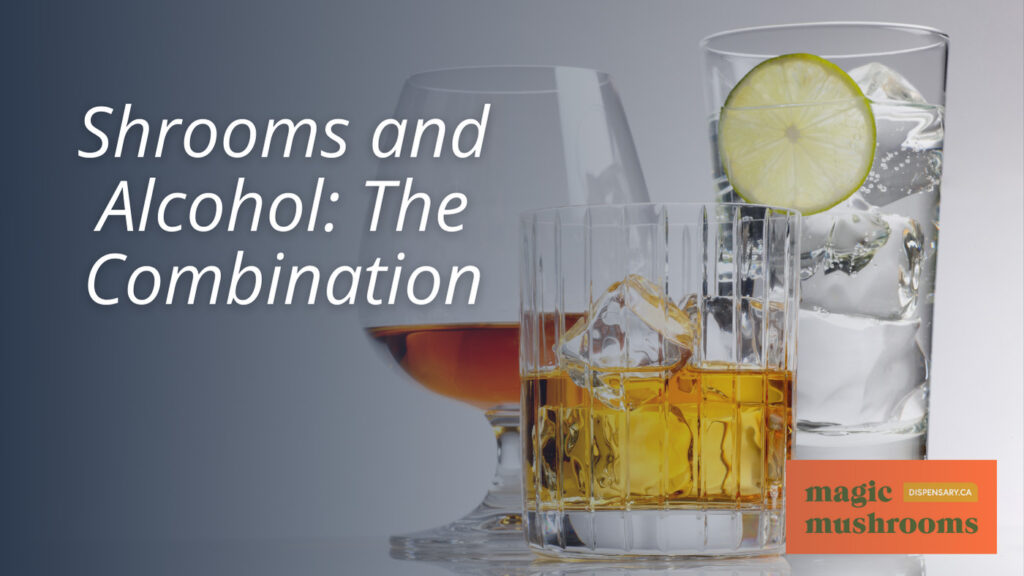
The amalgamation of shrooms and alcohol presents a slew of potential hazards, ranging from intensified impairment to heightened risks of disturbing hallucinations and impaired motor skills. This potent combination can exacerbate the effects of both substances, leading to an amplified state of intoxication. This intensified state may result in increased nausea, vomiting, headaches, panic attacks, and an overall sense of discomfort.
Additionally, the fusion of these two substances can usher in a state of impaired self-awareness and risky behaviours. These behaviours may lead to potential harm to both physical and mental well-being. The unpredictability of this combination, coupled with the potential for severe reactions, makes it a risky choice for those seeking liberation from their everyday constraints.
The interaction of shrooms and alcohol can also heighten the chances of experiencing disturbing hallucinations. These hallucinations, coupled with impaired motor skills, can increase the likelihood of accidents or injuries, further compounding the potential risks associated with this combination.
Moreover, the continued abuse of shrooms and alcohol may indicate underlying issues such as addiction. This combination can have long-term physical and mental health consequences that can be detrimental to an individual’s overall well-being. Therefore, understanding the interactions and potential dangers of mixing shrooms and alcohol is crucial for those seeking to make informed decisions about their substance use. In the pursuit of liberation, it is paramount to prioritize safety and be cognizant of the potential hazards associated with this combination.
Potential Risks of Mixing
Given the intensified state of intoxication and heightened risk of hallucinations discussed earlier, it is crucial to further explore the potential risks associated with combining shrooms and alcohol. Beyond the immediate physical impact, both substances can trigger an array of unpredictable reactions. Users may experience a so-called ‘bad trip’, characterized by severe anxiety, panic attacks, and an impaired sense of self. This can lead to risky behaviour, as the loss of self-awareness makes one more vulnerable to accidents and injuries.
Another risk is the potential for alcohol poisoning. The shrooms can mask the signs of intoxication, leading individuals to consume more alcohol than their bodies can safely metabolize. In this state of intensified inebriation, users may not only endanger themselves but others around them as well.
Continued abuse of this combination may be indicative of deeper issues, such as addiction. This co-dependency poses severe long-term health risks, both physical and psychological. Furthermore, the interaction between alcohol and shrooms can intensify hallucinations, elevate heart rate and blood pressure, and increase the risk of adverse events.
Ultimately, the combination of shrooms and alcohol is a high-risk endeavour that can lead to unpredictable and potentially harmful outcomes. As advocates for liberation, it is crucial to understand these risks, make informed decisions, and prioritize safety above all else when considering the consumption of these substances.
Physical Dangers of the Mix
Understanding the physical dangers of mixing shrooms and alcohol is crucial to ensuring one’s safety and well-being. This combination can lead to intensified side effects such as nausea, vomiting, and headaches. Furthermore, the absorption of psilocybin, the active compound in shrooms, can be enhanced by alcohol, which could bring about potent and potentially overwhelming hallucinogenic experiences.
Adding to the unpredictability are the potential reactions when alcohol is mixed with psychedelics. The outcomes can be erratic and unexpected, making it difficult for users to anticipate and manage their reactions. In the short term, this can lead to panic attacks and heightened anxiety, which are not only distressing but also potentially dangerous in certain situations.
Physical risks also extend to the cardiovascular system. Increased heart rate and blood pressure are common when consuming shrooms and alcohol. This can put undue stress on the heart, and in extreme cases, may even trigger cardiac events in those predisposed to them. The combination also impairs coordination and motor skills, raising the risk of accidents and injuries.
Long-term abuse of this mix can be detrimental to overall health. Chronic use of shrooms and alcohol can lead to organ damage, a risk that is often overlooked due to the focus on immediate, short-term effects. Ultimately, understanding these physical dangers is a crucial step towards liberation from the potential harm caused by the combination of shrooms and alcohol. This knowledge empowers individuals to make informed decisions that prioritize their safety and well-being.
Psychological Impacts to Consider
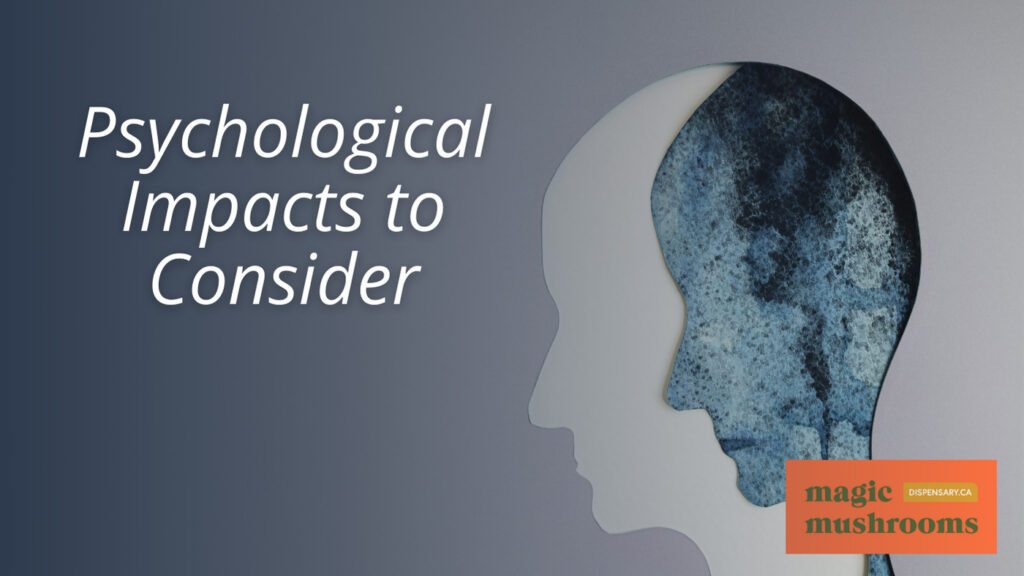
While the physical risks of combining shrooms and alcohol are undeniably serious, the psychological impacts also warrant careful consideration. The intertwining of these substances can lead to a potentiation of mental health conditions such as anxiety and depression. The volatile nature of this mix may heighten the risk of experiencing a ‘bad trip’, characterized by intense negative emotions, paranoia, and fear.
The effects of both shrooms and alcohol on neurotransmitter activity can drastically influence mood regulation and cognitive function. Psilocybin, the active component in shrooms, disrupts normal serotonin function, a key neurotransmitter in mood regulation. Concurrently, alcohol, a depressant, can exacerbate this disruption, leading to unpredictable mood swings and impaired cognitive function.
The psychological impacts can be particularly devastating for individuals with pre-existing mental health disorders. Such individuals are advised to avoid this combination due to the potential exacerbation of their conditions. It’s crucial to understand that the liberation sought from these substances can quickly turn into a mental health crisis if not approached with caution.
Lastly, for those grappling with substance abuse and mental health issues exacerbated by this mix, seeking professional help is essential. Mental health professionals, addiction specialists, and support groups can provide necessary guidance and resources. The journey to liberation should not be a solitary one, and help is readily available for those who need it. Understanding the psychological implications of mixing shrooms and alcohol is a vital part of this journey, promoting safety, awareness, and enlightened decision-making.
The Role of Tolerance
Navigating the complexities of substance tolerance plays a critical role in understanding the mixed consumption of shrooms and alcohol. Tolerance to substances like alcohol and mushrooms can develop, necessitating larger doses to attain the same effects over time. This need for escalating dosages emanates from the body’s adaptation to the regular presence of these substances, leading to reduced sensitivity.
Prolonged use of mushrooms, in particular, can lead to lasting effects in the system, which significantly impacts tolerance levels. These effects, coupled with the dulling of senses caused by alcohol consumption, contribute to an increased tolerance level for both substances. This increase in tolerance is not a sign of enhanced capacity to handle these substances but rather an indication of the body’s increasing dependence.
Building up a tolerance to mushrooms and alcohol may result in the need for higher doses to achieve desired effects. However, this escalation is not without risks. The higher the dose, the more intense and unpredictable the effects can be, increasing the chances of harm to physical and mental health.
Increased tolerance can also lead to potential challenges in managing substance use effectively. It often masks the severity of addiction, leading to a cycle of increased consumption and further tolerance development. The key is not to seek liberation through increased consumption but to prioritize safety and responsible use. Understanding the role of tolerance in this dynamic can help individuals make informed decisions about their substance use, fostering a healthier relationship with these substances.
Impact on the Psychedelic Experience
The intertwined effects of shrooms and alcohol significantly alter the psychedelic experience, introducing an array of potential risks and uncertainties. The use of alcohol in conjunction with psilocybin mushrooms, or shrooms, can intensify the hallucinogenic effects due to enhanced absorption of psilocybin. This enhanced absorption can lead to heightened sensations, unpredictable reactions, and potentially negative psychological effects.
Physical effects can also be notable. Alcohol can exacerbate the physiological changes associated with a psychedelic experience, such as an increased heart rate and blood pressure. This combination can also lead to dehydration, which can compound the physical discomfort often associated with such experiences.
The psychedelic experience can be unpredictable and potentially alarming, even in controlled settings. If alcohol is introduced into this equation, it can amplify the unpredictability, leading to heightened feelings of panic and nausea. This heightened unpredictability may contribute to the potential for a distressing or even terrifying experience, commonly referred to as a bad trip.
Moreover, the combined use of shrooms and alcohol can heighten the risk of negative emotional responses during the psychedelic experience. This could potentially worsen existing mental health conditions, leading to significant psychological distress.
While studies suggest a relatively low risk of unsafe behaviours when using psychedelics alone, caution is advised when they are combined with alcohol. The interaction can not only alter the psychedelic experience but also increase the potential risks and uncertainties associated with it.
Safety Precautions to Take
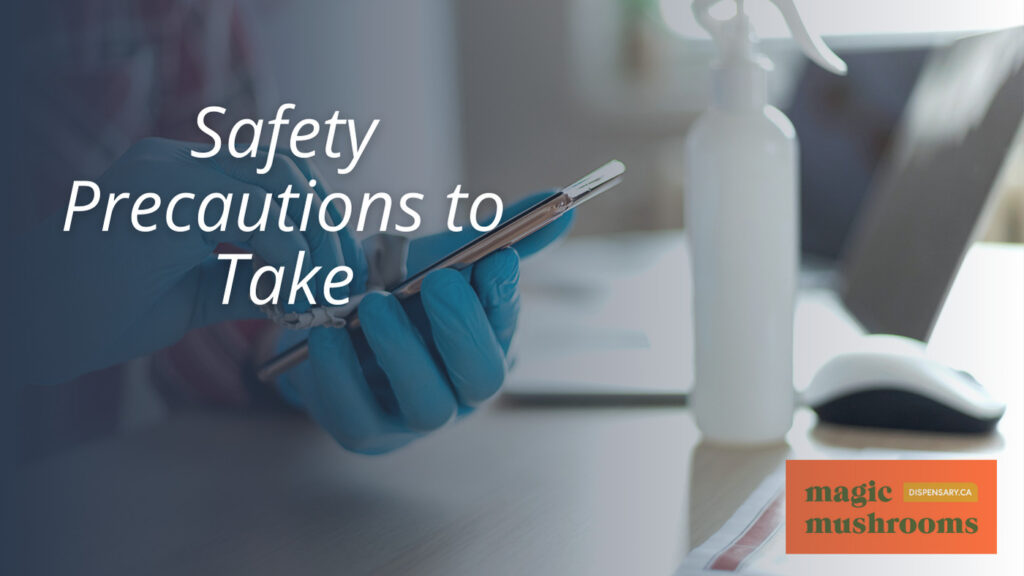
Given the potential risks associated with mixing shrooms and alcohol, certain safety precautions are essential to minimize harm and ensure a safer psychedelic experience. The key to a liberating and secure journey lies in knowledge and caution. Specifically, understanding the potential dangers of combining these substances is the first step towards harm reduction.
Avoiding the consumption of alcohol while using shrooms can help prevent the intensification of effects and potential risks. Each substance can alter perception and consciousness in unique ways, and their combined effects can be unpredictable and potentially hazardous. Therefore, setting consumption limits and consciously avoiding the mixing of substances can be effective strategies to reduce harm.
Another critical safety measure is to ensure the presence of a sober friend during the psychedelic journey. This sober companion can provide immediate assistance in case of emergencies or adverse reactions, acting as a grounding influence and a source of help if required.
In the event of experiencing concerning side effects or, in worst-case scenarios, an overdose from mixing shrooms and alcohol, seeking immediate medical help is crucial. Despite the desire for a liberating experience, the potential dangers should not be underestimated, and professional intervention may be necessary.
Ultimately, safety in the pursuit of liberation comes from education and responsible choices. By acknowledging the risks and taking the necessary precautions, one can navigate the psychedelic journey with more confidence and security. Remember, a truly liberating experience respects the boundaries of safety and health.
Expert Opinions on the Mix
In the realm of professional opinions, experts strongly discourage the combination of shrooms and alcohol due to the unpredictability of their interaction and the potential enhancement of unpleasant symptoms. This dual consumption can lead to intensified effects, such as queasiness, disorientation, and heightened sedative effects, which could potentially disrupt the ideal trip atmosphere sought by users.
Moreover, alcohol can dramatically amplify the effects of mushrooms. This amplification is not merely an intensification of the psychedelic experience, but it can lead to severe physical and mental consequences. Chronic misuse can escalate to addiction, a serious condition requiring professional intervention. Thus, the combination is seen as a risky venture, straying from the path of safe and responsible substance use.
Harm reduction strategies are strongly recommended by experts in the field. One such strategy is avoiding the combination of shrooms and alcohol altogether. By doing so, users can ensure a controlled and peaceful trip experience, minimizing the chance of adverse reactions.
Furthermore, experts recommend having a sober friend present during the trip, ensuring the environment is safe and comfortable, staying adequately hydrated, and seeking immediate medical attention if adverse symptoms develop. These guidelines are designed to promote a safe exploration of consciousness, without unnecessarily risking physical and mental health.
Personal Experiences: Case Studies
Diving into personal narratives, it becomes evident that the combination of shrooms and alcohol often leads to intensified hallucinations, heightened anxiety, and increased risks of negative experiences. Several case studies emphasize these outcomes, where individuals have reported alarming levels of intoxication, leading to unpredictability and potential harm.
One prevalent issue among users who have combined these substances is severe nausea and vomiting. The unpleasant physical reactions do not just stop at the gut level; they usurp the entire experience, leading to disorientation and often distress. This disorientation can be especially daunting for those seeking a liberating psychedelic experience, as it can swiftly turn into an overwhelming ordeal.
Further, reports of panic attacks and debilitating headaches are not uncommon among those who have mixed alcohol and shrooms. The heightened anxiety experienced is a significant departure from the sense of enlightenment and self-exploration often associated with psilocybin use. Instead of fostering self-discovery, this mix has been shown to induce a state of confusion and fear, severely detracting from the intended journey of personal growth.
Impaired coordination, risky behaviour, and confusion are other negative consequences cited in these case studies. Such outcomes underscore the importance of caution and professional guidance when considering the consumption of such substances. Based on these personal narratives, it is clear that the mixture of shrooms and alcohol often leads to adverse experiences, negating the potential benefits of a controlled, solitary psychedelic experience. Hence, the pursuit of liberation and self-discovery should not involve mixing these substances recklessly.
Medical Research on the Combination
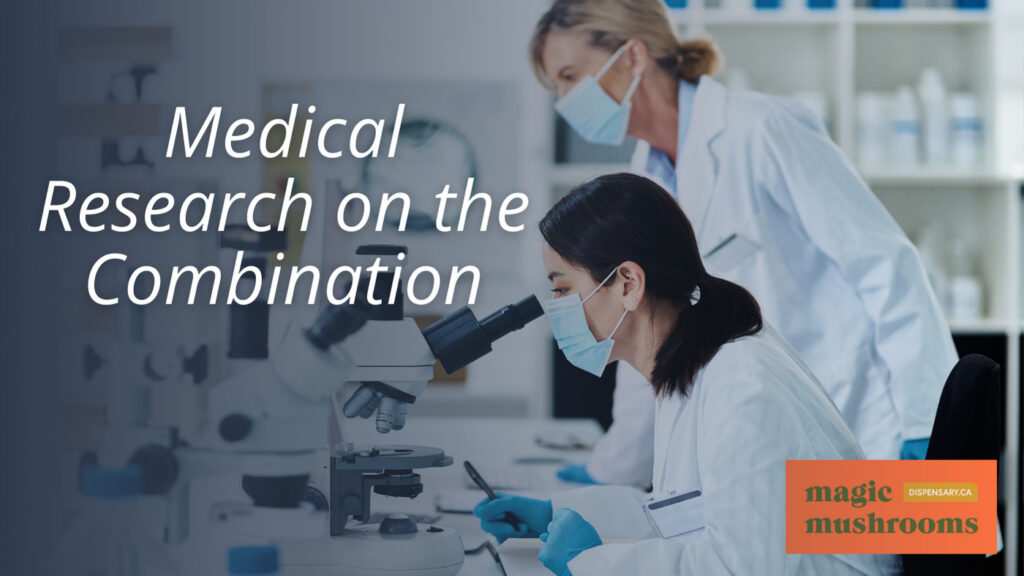
While personal anecdotes are valuable, a comprehensive understanding of the effects of mixing shrooms and alcohol necessitates an examination of the scientific research conducted on this combination. The available literature indicates that the amalgamation of these substances can lead to intensified effects such as enhanced hallucinations, increased anxiety, and physical discomforts like headaches, nausea, and vomiting. The magnified intensity of these effects is possibly due to enhanced absorption of psilocybin, the active compound in shrooms, when consumed with alcohol.
Furthermore, the combination of shrooms and alcohol presents substantial strain on the liver due to the shared metabolism requirements of both substances. This increased load on the liver not only exacerbates the potential for harm but also escalates the risks associated with chronic use, posing potential long-term health concerns.
Contrasting this, some medical research suggests a potential benefit of psychedelics, specifically psilocybin, in reducing alcohol intake. However, it is crucial to note that this does not endorse the simultaneous consumption of shrooms and alcohol. The potential benefit is largely isolated to controlled environments under medical supervision.
Legal Implications to Understand
Navigating the legal landscape associated with the possession and use of psilocybin-containing mushrooms and alcohol is a vital aspect of understanding the risks involved. Despite the growing conversation about the potential therapeutic uses of psilocybin, the possession and distribution of these mushrooms remain illegal in many jurisdictions. This means individuals found with these substances could face significant legal consequences, including fines, imprisonment, or both.
When alcohol is added to the mix, the legal ramifications can multiply. Driving under the influence of either substance is a serious offense and can lead to severe penalties. Furthermore, unpredictable reactions resulting from the combination could lead to situations that infringe upon the law, amplifying the legal jeopardy.
Legal penalties for drug-related offences often have far-reaching impacts, extending beyond the immediate legal consequences. They can leave a lasting imprint on one’s record, which could affect future opportunities, including employment and housing. Hence, adhering to laws surrounding the use of these substances is paramount.
Being aware of the legal implications of mixing shrooms and alcohol is an essential facet of risk assessment. This knowledge empowers individuals to make informed decisions about their actions, potentially avoiding detrimental legal outcomes. However, it’s important to remember that laws surrounding drug use are complex and can vary widely. It’s always advisable to consult with a legal expert when in doubt. In conclusion, understanding the legal landscape is as crucial as comprehending the physical and mental effects of mixing shrooms and alcohol.
Harm Reduction Strategies
Beyond understanding the legal implications, it’s equally vital to explore harm reduction strategies when considering the use of shrooms and alcohol. Education serves as the foundation for these strategies. This includes understanding the potential dangers and effects of combining these substances, such as increased intoxication, unpredictable reactions, and possible harm to physical and mental health. Knowledge empowers individuals to make informed decisions and prioritize safety, thereby reducing potential harm.
Setting consumption limits is another critical harm reduction strategy. Avoiding the simultaneous use of shrooms and alcohol can reduce the risk of unexpected reactions and excessive intoxication. It’s crucial to remember that every individual responds differently to these substances, and what might be a manageable dose for one person could be excessive for another.
Having a sober friend present during mushroom use can also be beneficial. This individual can assist with emergencies, ensuring that immediate help is available if adverse reactions or overdoses occur. This sober companion can also help maintain a safe environment and ensure that the individual using the mushrooms does not engage in risky behaviour.
Advice for First-Time Users
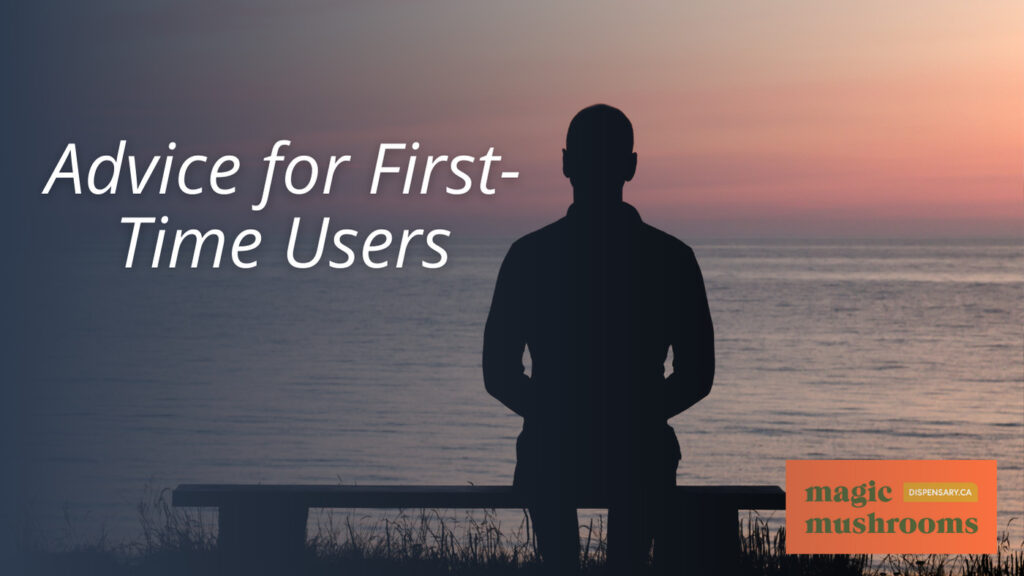
For individuals considering their initial foray into combining shrooms and alcohol, it is paramount to approach the experience with utmost caution and ample knowledge about potential effects and risks. In the pursuit of liberation, it is essential to be aware of the increased intoxication and unpredictable reactions that may occur. It is also vital to acknowledge the potential adverse effects on physical and mental health. A holistic understanding of the interactions between shrooms and alcohol is the first step to ensuring safety.
First-time users are strongly advised to start with a low dose. This measured approach allows individuals to gauge their sensitivity to the combination of shrooms and alcohol, thereby minimizing the risk of a negative reaction. It is also a prudent strategy to have a trusted, sober friend present during the initial experience. This precaution provides an additional layer of safety in case of unforeseen adverse reactions.
Creating a comfortable and safe environment is also crucial. The setting can significantly influence the experience and can contribute to a positive first experience. Lastly, seeking professional guidance or advice is highly recommended. Professionals can provide valuable insights into harm reduction strategies and can help individuals make informed decisions.
Alternatives to Mixing Shrooms and Alcohol
While the combination of shrooms and alcohol carries notable risks, there are safer alternatives to consider for those seeking to explore the therapeutic potential of psychedelics. Instead of resorting to dangerous combinations, one can consider the use of psychedelics in a controlled therapeutic setting. Professional guidance is key in these circumstances, as it paves the way for a safer and more mindful exploration of the self through the use of psychedelics.
Another viable alternative is participation in psilocybin-assisted therapy programs. These programs can be particularly effective for those dealing with addiction issues, providing a supportive and structured environment that facilitates healing and recovery. Instead of mixing shrooms with alcohol, which can result in intensified and unpredictable effects, these programs therapeutically use psilocybin.
Moreover, support groups and counselling can be invaluable resources for individuals battling substance use issues. By engaging with others who are travelling similar paths, one can gain the insights and camaraderie necessary for a successful journey towards liberation.
Furthermore, education plays a critical role in harm reduction. By understanding the risks associated with combining shrooms and alcohol, individuals can make informed decisions that prioritize their health and well-being. Learning about healthier coping mechanisms and harm-reduction strategies can also be beneficial.
The Impact on Mental Health
The potential implications of mixing shrooms and alcohol on mental health are significant and should not be underestimated. This potent combination can exacerbate existing mental health conditions such as depression and anxiety, making them more difficult to manage. The amplification of these disorders not only disrupts daily functioning but also impedes the journey towards self-liberation that many individuals strive for.
The risk of experiencing a bad trip, characterized by intense negative emotions and paranoia, is markedly heightened when mushrooms are combined with alcohol. This can lead to a state of mental distress and instability, which can have devastating effects on an individual’s psychological well-being. Empowering oneself with knowledge and awareness of these potential risks is a crucial step towards safeguarding mental health.
Moreover, the interaction between alcohol and shrooms disrupts neurotransmitter activity, which plays a pivotal role in regulating mood and cognitive function. This disruption can lead to fluctuations in mood and impaired cognitive abilities, further hindering one’s capacity to function optimally and achieve the desired liberation.
Particularly for individuals with pre-existing mental health disorders, the combination of shrooms and alcohol presents potential risks that are far too great. Such individuals should abstain from this hazardous mix to protect their mental health.
Lastly, for those grappling with substance abuse and concurrent mental health issues, seeking professional help is of utmost importance. Trained professionals can provide the necessary tools and support to help individuals navigate their path to recovery and liberation. Thus, understanding the profound impact of mixing shrooms and alcohol on mental health is essential.
Long-Term Consequences to Consider
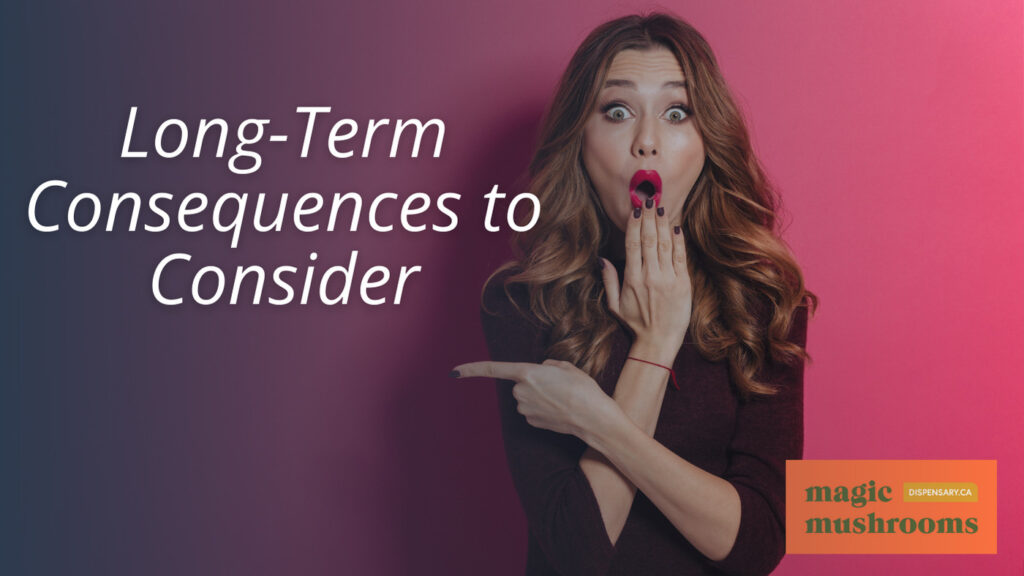
Beyond the immediate impact on mental health, one must also consider the long-term consequences of combining shrooms and alcohol. The strain on the liver is a significant concern as both substances require liver metabolism. Prolonged use of this combination can lead to chronic health issues such as an increase in heart rate and blood pressure, dehydration, and impaired coordination. This consistent internal stress can lead to lasting organ damage, further compounding the risks associated with this substance mix.
In addition to physical health, long-term mental health effects are a major concern. The combination of shrooms and alcohol can worsen existing conditions like anxiety and depression by affecting mood regulation and cognitive function. Overdosing on shrooms, whether intentional or accidental, can potentially lead to psychosis or even death. Furthermore, there is the ever-present risk of accidentally consuming poisonous mushrooms, which poses its own set of severe health threats.
Legal ramifications also merit consideration. Driving under the influence and drug-related offences not only carries immediate penalties but can have lasting impacts on one’s record. This can limit future opportunities, affecting everything from employment prospects to travel abilities. Ensuring one’s liberation necessitates understanding and weighing these potential long-term consequences before deciding to mix shrooms and alcohol. Ultimately, the desire for liberation should not compromise one’s physical and mental health, nor jeopardize their legal standing. Instead, it should inspire careful consideration of the choices we make and the potential impact they may have on our long-term well-being.
The Social Aspect of Mixing
How does the social aspect of mixing shrooms and alcohol manifest, and what are the potential repercussions? When these substances are combined, it can lead to impaired judgment and decision-making. This can have a substantial impact on social interactions, as individuals may behave unpredictably or have difficulties distinguishing reality from hallucinations. One might say or do things they wouldn’t normally do, possibly damaging relationships or their reputation in social circles.
Moreover, the physical effects of mixing these substances can significantly influence social situations. Impaired motor skills can raise the risk of accidents and injuries, potentially creating hazardous situations for both the individual and those around them. This can lead to further social repercussions, such as ostracization or legal troubles.
Emotional instability is another repercussion of mixing shrooms and alcohol. Fluctuating moods can make social interactions challenging and may result in strained relationships. Furthermore, the combination of these substances can lead to legal and health implications that have lasting effects on one’s social life and personal well-being.
In our quest for liberation, it is crucial to understand these potential social ramifications. Being aware of the consequences can encourage safer practices and more informed decision-making when it comes to substance use. After all, our actions, especially in social settings, do not only affect us but also those around us. Therefore, it is our responsibility to consider these implications and act accordingly. In the end, the goal is not only personal liberation but also a safer, healthier community.
Debunking Myths About Mixing
In the realm of substance use, misconceptions often abound, particularly concerning the mixing of shrooms and alcohol. Foremost among these myths is the belief that co-consumption simply intensifies the recreational effects, enhancing the overall experience. However, this notion is dangerously misleading.
The interaction between shrooms and alcohol is not merely additive; it’s unpredictable. The intensification of the hallucinogenic effects is not a guaranteed outcome. The alcohol can either dull the psychedelic experience or exacerbate its intensity, leading to a disorienting and potentially distressing situation.
Another prevalent myth suggests that alcohol can soften the impact of a bad trip, acting as a safety net. In truth, the combination can strain the liver, which is tasked with metabolizing both substances simultaneously. This can lead to both short-term discomfort and long-term health concerns.
Furthermore, it’s a common misconception that mixing these substances is a widely accepted practice with minimal risks. The reality is that this combination can exacerbate mental health conditions and increase the likelihood of a negative psychedelic experience or “bad trip.”
Making Informed Decisions

Given the potential dangers and unpredictable effects of combining shrooms and alcohol, it is imperative to make informed decisions when contemplating their concurrent use. This is not a matter of personal preference or casual experimentation. It is about understanding the very real risks that come with mixing these substances and making choices that prioritize your well-being.
The intensification of impairment is one such risk. When shrooms and alcohol are combined, the effects of both substances are heightened, leading to a level of intoxication that can be dangerous. This can result in unpredictable reactions, from physical symptoms like nausea, vomiting, and headaches, to psychological effects like disturbing hallucinations, otherwise known as “bad trips”.
These negative outcomes are not guaranteed, but their possibility alone should serve as a strong deterrent. They underscore the importance of taking a careful and thoughtful approach when considering the use of shrooms and alcohol. This requires research, reflection, and, ideally, consultation with knowledgeable professionals or trusted sources.
In the quest for liberation, it is important to remember that true freedom comes from understanding and respecting our boundaries, not pushing them recklessly. Combining shrooms and alcohol is not a path to enlightenment or transcendence; it is a gamble with your health and safety.
Frequently Asked Questions
What Are the Societal Perceptions of Mixing Shrooms and Alcohol?
Societal perceptions of mixing shrooms and alcohol vary widely. While some may view it as a form of self-expression or exploration, others see it as reckless behaviour due to potential health and safety risks. Many health professionals and societies caution against this combination due to its unpredictable effects and potential harm to both physical and mental health. The lack of comprehensive research in this area also contributes to the overall apprehension towards the practice.
How Does the Combination of Shrooms and Alcohol Affect an Individual’s Ability to Operate Machinery or Drive?
The combination of shrooms and alcohol can significantly impair an individual’s ability to operate machinery or drive. This mix intensifies psychoactive and physiological effects, leading to impaired judgment, slower reaction times, and altered perception. This volatile concoction could result in dangerous situations, as the distorted reality and impaired motor control can greatly compromise safety. Thus, it is strongly advised to avoid operating any machinery or driving under the influence of these substances.
Are There Any Cultural or Historical Practices Related to Mixing Shrooms and Alcohol?
Historically and culturally, the practice of mixing psilocybin mushrooms and alcohol is not widely documented or prevalent. Most indigenous traditions that use psilocybin mushrooms for spiritual or medicinal purposes advocate for their use in a controlled and respectful manner, often without the combination of other substances like alcohol. This is likely due to the potential for unpredictable reactions and increased health risks when these substances are mixed.
How Does Mixing Shrooms and Alcohol Impact a User’s Personal Relationships or Social Life?
Mixing shrooms and alcohol can significantly impact a user’s personal relationships and social life. The unpredictable reactions and heightened intoxication may lead to erratic behaviour, causing strain in relationships. Moreover, the potential for harmful physical and mental effects could lead to social withdrawal or isolation. It’s important to note that these impacts can vary greatly among individuals and depend on the frequency and quantity of substance use.
Are There Any Specific Demographics That Are More Likely to Mix Shrooms and Alcohol?
Research has not definitively identified specific demographics more likely to mix psilocybin mushrooms and alcohol. However, usage trends indicate that younger adults, particularly those in college settings, may be more prone to experimenting with such combinations. It’s crucial to note that the risks associated with mixing these substances apply universally, regardless of age, gender, or other demographic factors. Safety should always be prioritized when dealing with potentially harmful substances.
Conclusion
In conclusion, combining psilocybin mushrooms with alcohol can lead to intensified, unpredictable effects, and potential physical and mental harm. For example, a hypothetical individual who ingests this combination could experience heightened hallucinations, leading to dangerous behaviour or sustained psychological distress. As such, the importance of making informed choices about substance use, focusing on safety and harm reduction, should be emphasized. Understanding the potential risks associated with combining these substances is essential for responsible recreational use.
Buying Microdosing Mushrooms Online in Canada
Are you an avid microdoser or looking to venture into the art of microdosing? Working with a reliable, trustworthy shrooms dispensary is paramount in your journey of becoming a better version of yourself. Magic Mushroom Dispensary prides itself on its comprehensive collection of top-notch microdosing products, psilocybin books, excellent customer service, and fast, discreet shipping. Visit our online shop today and enjoy low prices and free shipping for orders above $99.
Originally posted on February 16, 2024 @ 6:43 am

